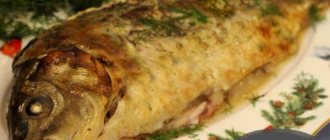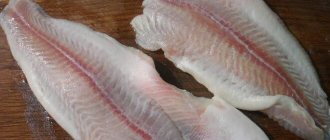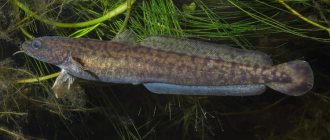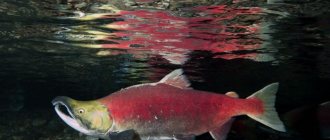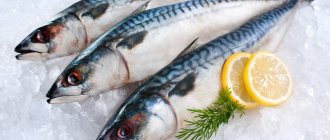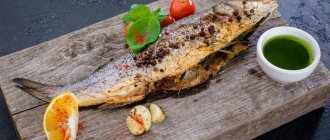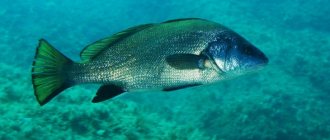Fish are a vast group of aquatic creatures; the number of currently known species alone numbers in the tens of thousands on earth. And every year scientists discover and describe up to five hundred new varieties. Among such living organisms, loaches stand out - a family that unites in its ranks small freshwater fish with an increased ability for intestinal and skin respiration. Thanks to this feature, these living organisms are able to exist in an aquatic environment that is very poor in oxygen. The smallest representative of the mentioned family is the spined fish. Such creatures usually do not grow more than 10 cm in length. Moreover, these are only females; males, as a rule, are even smaller.
Description
The life activity of such representatives of aquatic fauna is carried out in fresh lakes and rivers. Fish prefer to stay near the bottom rich in silt and sand. And since these creatures have a long, narrow and flexible body, from the outside they look very much like water snakes or lizards running on soft ground. And at the slightest danger, the spined fish strives to hide in its saving depths as quickly as possible, burying itself in the sand.
These representatives of the aquatic fauna are not the brightest, but variegated in color. It is a pattern of an abundance of dark small spots scattered on a brown, light yellow or simple gray background. The characteristics of the color scheme usually directly depend on the environment where the life of such fish takes place. Nature made sure that their colors blended with the bottom of the reservoirs where they live, making them barely noticeable to the enemy eye. The fins are usually light gray in color, some of them covered with dark spots and stripes. The description of the pickled fish is complemented by a photo where all its features are clearly visible.
Economic importance
Pinched fish has no commercial significance. It is the food source for many fish. Due to its grace, beautiful appearance, and ability to predict the weather, many amateur aquarists keep it at home. In captivity, they quickly adapt, grow and reproduce well.
Sources: ru.wikipedia.org , sevin.ru , wwlife.ru
Similar articles:
Chir
Chir, or shokur (Yakut. Chyir, mun, ur, Young chir - Khara Atah (Yana)) is a freshwater fish from the whitefish family….
Sterlet
Sterlet (lat. Acipenser ruthenus) is a fish of the sturgeon family. Body length reaches 125 cm, weight - 16 kg. Sterlet belongs to the sturgeon family, and we can say that it is perhaps the most remarkable fish of all sturgeon species. Even despite its relatively small size...
Ide
Ide (Yakut. Ten) is a species of fish from the carp family. Young fish are called roaches….
Omul
Omul (Yakut. Uomul) is a Siberian representative of the salmon family. The fish has very fatty and tasty meat. This species is very popular in fishing, as well as among professional and amateur fishermen….
Asian smelt
Asian smelt, or American smelt (Yakut. Timir atah). Smelt is a migratory fish and has freshwater lake subspecies. Widespread and highly populated...
About the name
It would be nice to take a closer look at some of the details of the appearance of such creatures. Under the small eyes of these fish, a pair of bipartite spines can be distinguished on the gill covers. And it was they who served as the reason for the name, consonant with the word “pinching”. These devices have an interesting property, as they are endowed with protective functions. In case of danger, the spikes spontaneously extend and are quite capable of injuring enemies and offenders.
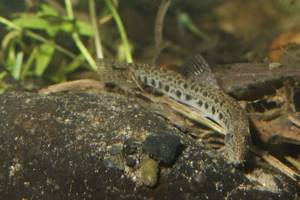
Among other remarkable details of the appearance of the pickled fish (the photo shows this) are six small antennae that are located near the mouth. And the entire body of the described aquatic creature is covered with barely noticeable, very small scales.
Distribution and habitat
In Russia, these representatives of freshwater fauna are distributed almost throughout the entire territory; they are found in rivers such as the Volga and Ural, in Lake Tavatuy and other reservoirs. Such creatures also live in large rivers and lakes throughout Eurasia.
The spined fish has the ability to feel comfortable in both running and standing water. And in addition to large bodies of water, it can sometimes be found in ditches and springs. The main thing is that the current in this place is not too strong. The fish also avoids places that are too deep. In summer, these creatures often simply hide in mud or silt, exposing only a small head. If the weather is good, the fish may simply rest on the bottom.
Fishing
The breathing characteristics of such creatures allow them not only to successfully survive in waters where there is a clear lack of oxygen. They are able to exist for quite a long period, remaining in the atmospheric air. Therefore, the pickled fish remains fresh for a considerable time, having been caught by a successful fisherman.
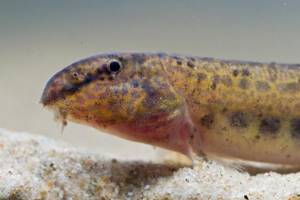
To catch such prey, ordinary earthworms are most often used. Fishing with a net is also successful. Such fish often get caught in it, accidentally getting caught in their famous spines, while being completely unable to get out. Also, the spined fish itself is often used as bait to catch larger fish. This is how they catch burbot, pike perch, and perch.
Keeping in an aquarium
The spined lance is a small fish, but very cute, so it is very suitable for aquarium keeping. In addition, it is important to take into account the harmless nature of such tiny creatures, therefore, they can be placed together with any neighbors. And it doesn’t matter whether they are large or small, as long as they themselves do not pose a danger to such a fish.
By the way, spined lances may well play the role of a living barometer in the house, since they react in a very unique way to fluctuations in atmospheric pressure. They show nervous activity, rush about, and often swallow air convulsively through their mouths. Thus, these creatures of nature are able to warn their owners about weather changes. That is, the pickled fish in an aquarium is a real home weather station.
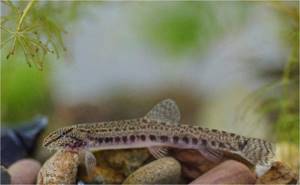
When purchasing such small pets, especially if you plan to get offspring from them in the future, it is very important to learn how to distinguish males from females. The former can be distinguished by the significant size of their pectoral fins. Males also have flattened sides, a narrow muzzle and are smaller in size - about 8 cm. Females are more cheeky, and can be one and a half times larger in body length.
Shchipovka
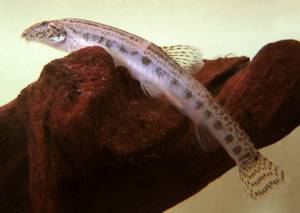
(Cobitis taenia Linné , 1758)
There is another Russian version of the name - “Shipovka”. Both names indicate, in essence, the same property of the fish - “pinching” with the help of a sharp spike on its gill covers... Belongs to the order Cypriniformes, suborder Cyprinoidei, family Cobitidae. The fish lives in reservoirs throughout almost all of Europe. It prefers rivers and lakes with sandy-muddy soil (burrowing into it), but is also found in fast currents (however, then climbing into dense thickets of aquatic plants). The male has a narrower muzzle, when viewed from above, almost flattened laterally, has larger and thicker pectoral fins; its length is 7–9 cm. The female, with a more “cheeky” muzzle, when viewed from above, has a body that is narrow at the ends and widening in the middle, the pectoral fins are smaller and thinner; its length is 10–15 cm.
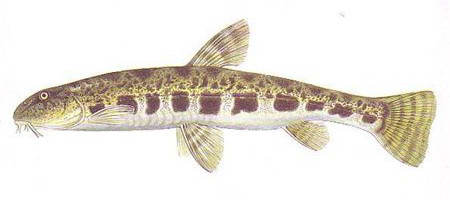
The range of water parameters for keeping spined loach is very wide : pH from 6 to 8, gH from 4 to 20 (and higher). It can withstand water temperatures from 3 to 30°. The only requirement is that there are no stones with sharp edges in the aquarium, on which the fish can get injured, sometimes moving with sudden jumps along the bottom of the aquarium. If the soil is shallow, the spined loaches will bury themselves in it, emerging only when feeding. If the soil is large, they can do just fine without digging, moving along the bottom and “sifting” through the mouth and gills any organic remains (including drowned dry food)... Since the fish is absolutely harmless, you can keep it with neighbors of any size, as long as they themselves have no idea danger for plucking. Like most loach fish, it serves as a living barometer. Before the atmospheric pressure (and, accordingly, the weather) changes, it begins to actively rush around the aquarium, often swallowing air...
Reproduction of spined lice in an aquarium is quite possible. To do this, it is recommended to keep them at a lower temperature in winter (10° and below). But if winter “cooling” is unrealistic, it is enough to simply distribute males and females in different aquariums for the winter. At the same time, it is also desirable that in the winter there are no fish in the aquarium with spined lances that spontaneously spawn there (so that the hormones they secrete do not “stimulate” the spined lice ahead of time).
When the time comes for these fish to reproduce in nature (May-June), you can again combine the spined fish in one aquarium (and then it becomes desirable for them to be accompanied by fish with regular portioned spontaneous spawning - iris, carp, cardinals, etc.) . Two weeks of being in the same aquarium with the listed fish (and feeding with any live food) is usually enough for the male spined lance to become more and more actively chasing the female. At the same time, the female’s abdomen increases slightly. Then a couple of fish should be transplanted into an aquarium with fresh water (pH = 6.5 -7, gH = 6 -9, t26 -28°) and aeration. An aquarium is preferably about 15–20 liters, without soil, with a large bunch of Java moss pressed down on a stone in the middle. Continue to provide live food. There should be light around the clock...
Under these conditions, the “ripening” of fish lasts from 2 to 5 days. The movement of fish becomes more and more active and fast; they almost never stop and do not lie down on the bottom - and the male practically does not lag behind the female, almost sticking to her back. Finally, they “fly” into a thicket of moss and make a rapid jump in a circle (like the head of a screw). But the release of eggs may not yet occur for several hours - the fish seem to be rehearsing for spawning. Then, at some point in the next “rotation”, the male wraps himself around the female for a moment - and eggs and milk are released! Such releases (up to 15–20 eggs at a time) are occurring more and more often. The caviar is initially flattened and small; it, without sticking, sinks into the moss and after 10–15 minutes swells, almost tripling in size. Spawning continues for a long time - 5-6 hours - and at the end of it, the fish lie exhausted on the bottom. Then the producers need to be planted.
At the above temperature, the larvae hatch literally in a day, without yet having any external organs, not even eyes! They lay there like that, occasionally bouncing weakly, for another three days. Then they develop eyes and external gills (in the form of thin bushes behind the eyes) - and, having become fry, they begin to feed. For feeding, either the smallest microworm (enchytraea) or the Sulfur Micron food is suitable. If you grind it in water, it gradually sinks to the bottom, and the fry eat it. 3-4 days after the start of feeding, you can start changing the water and turning off the lights at night. The fry grow quickly - after 2 weeks they can already reach a centimeter length. They will be able to reach sexual maturity next year at a length of 6–7 cm.
Feeding aquarium fish should be correct: balanced, varied. This fundamental rule is the key to the successful keeping of any fish, be it guppies or astronotuses. The article “How and how much to feed aquarium fish” talks about this in detail; it outlines the basic principles of the diet and feeding regime of the fish.
In this article, we note the most important thing - feeding fish should not be monotonous; the diet should include both dry food and live food. In addition, you need to take into account the gastronomic preferences of a particular fish and, depending on this, include in its diet food either with the highest protein content or, conversely, with plant ingredients.
Popular and popular food for fish, of course, is dry food. For example, you can constantly and everywhere find food on aquarium shelves - the leader of the Russian market; in fact, the range of food for this Tetra is included as individual food for a specific type of fish: for goldfish, for cichlids, for loricariids, guppies, labyrinths, arowanas, discus, etc. .d. Tetra has also developed specialized foods, for example, to enhance color, fortified, or for feeding fry. You can find out detailed information about all Tetra feeds on the company’s official website - here .
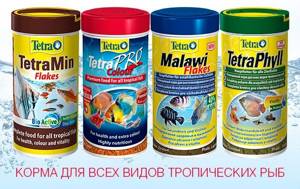
It should be noted that when purchasing any dry food, you should pay attention to the date of its manufacture and shelf life, try not to buy food in bulk, and also store the food in a closed state - this will help to avoid the development of pathogenic flora in it.
All of the above is just the fruit of observing this type of aquarium fish and collecting various information from owners and breeders. We would like to share with visitors not only information, but also live emotions that allow us to understand the world of aquariums more fully and subtly. Register at https://fanfishka.ru/forum/ , participate in discussions on the forum, create profile topics where you will talk about your pets in the first person and first-hand, describe their habits, behavioral features and content, and share with us your successes and joys, share your experiences and learn from the experiences of others. We are interested in every bit of your experience, every second of your joy, every awareness of a mistake, which makes it possible for your comrades to avoid the same mistake. The more of us there are, the more pure and transparent drops of goodness there are in the life and everyday life of our seven billion society.
FanFishka.ru thanks the author V.M. Chernyavsky
for cooperation and provided material.
How to feed?
The successful maintenance of any fish depends on proper feeding. Pinching is no exception. During aquarium life, such domestic creatures should not eat monotonously. The diet should be varied and must include both live and dry food. It is also important to take into account individual preferences in this matter. They determine the diet and whether it should consist more of plant ingredients or mainly contain protein.
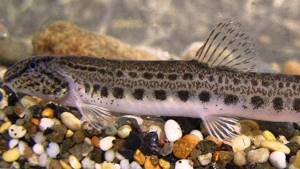
In nature, these creatures feed on insects, larvae and small invertebrates. At home, they turn out to be almost omnivores. However, frozen food may not attract the attention of such fish. As for the size of portions, it is better if they are moderate. And food should be offered to pets no more than once per day.
Fish from the same family:
- Cherry barb (Barbus titteya)
- Barbus pentazona
- Fire barb (Barbus conchonius)
- Sumatran barb (mutant) (Barbus tetrazona var.)
- Four-line barb (Barbus Lineatus)
- Green barb (Barbus semifasciolatus)
- Black barb (Barbus nigrofasciatus)
- Sumatran barb (Barbus tetrazona)
- Scarlet barb (Barbus ticto)
- Clown Barbus (Barbus everetti)
- Barbus filamentosa
- Barbus arulius
- Goldfish "Water Eyes" (Carassius auratus)
- Veiltail goldfish (Carassius auratus)
- Danio rerio (Brachydanio rerio)
- Danio equipinnatus. Malabar danio (Danio aequipinnatus)
- Cardinal (Tanichtys albonubes)
- Green Labeo (Labeo frenatus)
- Labeo bicolor
- Scarlet barb (Barbus stoliczkae)
- Odessa barb, scarlet (Barbus spec. var. ticto, Barbus ticto “Odessa”)
- Barbus butterfly. Barbus. moth (Barbus hulstaerti)
- Two-point barb (Barbus bimaculatus)
- Barbus "Schuberti"
- Barbus lateristriga
- Striped barb (Barbus fasciatus)
- Island barbel (Barbus oligolepis)
- Danio blue. Thai Danio (Brachydanio kerri)
- Danio pearl. Pink Danio (Brachydanio albolineatus)
- Leopard danio (Brachydanio rerio var. frankei)
- Spot zebrafish (Brachydanio nigrofasciatus)
- Common gudgeon (Gobio gobio)
- Minnow. Demoiselle minnow (Phoxinus phoxinus)
- Danio devario
- Laubuka Dadiburjora. Chela dadiburjori
- Indian laubuca (Chela laubuca)
- Gorchak (Rhodeus sericeus amarus)
Editorial: Neon gold

